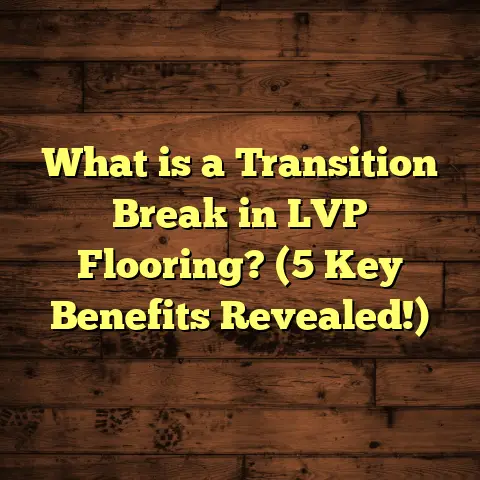What is a Floor Joist? (5 Key Functions You Should Know)
Have you ever walked through an old house
and paused to wonder what supports all that
weight beneath your feet? Maybe you’ve
noticed your floor creak or feel a little bouncy,
and thought, “What’s really holding this up?”
For me, that curiosity started years ago when
I was helping my uncle renovate his century-old
farmhouse. The floors there had seen better days—
some boards sagged, others squeaked like crazy.
I soon learned that the secret to a solid floor lies
in something you seldom see: the floor joists.
These beams are the backbone of every floor—
they quietly bear the load of everything above,
from the floorboards themselves to all your furniture
and even you walking around. Over the years,
I’ve worked on countless projects involving joists,
and I want to share with you everything I’ve learned.
Let’s start by exploring exactly what a floor joist is,
then dive into its key functions, practical tips, and
why understanding them could save you time and money.
What Is a Floor Joist?
A floor joist is a horizontal structural member that
supports the floor system in buildings. You can think
of it as one of many parallel beams running beneath
your floorboards, providing the necessary strength and
stability to hold everything above.
Joists typically run from one foundation wall or beam to
another, spaced evenly apart to distribute weight evenly.
Materials and Sizes
While traditional floor joists are often made from solid wood—
usually dimensional lumber like 2x8s, 2x10s, or 2x12s—there’s a wide range of materials used today.
Engineered wood products—such as laminated veneer lumber (LVL),
parallel strand lumber (PSL), and I-joists—are popular for their strength and ability to span longer distances without support.
Steel joists also find use in commercial or heavy-duty residential construction for their durability and resistance to warping.
Joist Span and Spacing
The length a joist can span depends on its size, material, and how much weight it needs to carry. For example:
- A 2×8 pine joist can span about 12 feet with typical residential loads.
- A 2×10 can go up to around 15 feet.
- LVL or I-joists can exceed 20 feet in some cases.
Spacing is usually 16 inches on center (o.c.), meaning each joist is placed 16 inches apart from the center of one joist to the next. Some floors use 12-inch or 24-inch spacing depending on design requirements but moving beyond 16 inches can lead to flexing or bouncing floors.
The Layers Above and Below
Joists sit below the subfloor layer—usually plywood or oriented strand board (OSB)—which is nailed or screwed directly onto the joists. Above the subfloor comes your finish flooring: hardwood, tile, carpet, or vinyl.
Below the joists is often a crawlspace or basement where you can see the joists clearly from underneath.
Personal Story
When I first got involved with flooring renovations, one project taught me the critical role joists play. We were working on a Victorian-era home where the original joists were narrow boards spaced 24 inches apart. The floors felt like trampolines—bouncy and noisy. Replacing those with wider, closely spaced joists transformed the feel of every step inside that house.
5 Key Functions of Floor Joists You Should Know
Now that we know what they are, let’s talk about what joists actually do. Their roles might seem straightforward, but each one is essential for a safe and comfortable floor.
1. Supporting Structural Load
At its core, a floor joist carries the structural load of everything above it. This includes:
- Dead Load: Weight of the flooring materials themselves (subfloor, finish flooring) plus fixed structures like built-in cabinets.
- Live Load: Weight of people, furniture, appliances—anything that moves or changes.
Joists transfer this load horizontally to beams or load-bearing walls below, which then channel it down to the foundation and soil. Without strong joists sized correctly for the load, floors can sag or fail.
Data Insight
The International Residential Code (IRC) requires residential floors to support a minimum live load of 40 pounds per square foot (psf) plus a dead load of approximately 10 psf. That means every square foot of floor must safely hold at least 50 pounds on average.
In my experience reviewing building plans, undersized joists were a common issue in older homes that didn’t meet these modern standards. Upgrading joists not only improved safety but also reduced floor bounce significantly.
2. Providing a Nailing Surface for Flooring
Joists create a solid base for attaching subfloor panels like plywood or OSB. These panels then provide a flat surface for your finish floor—whether hardwood planks, tiles, or carpet.
If joists are spaced too far apart or damaged, the subfloor can flex underfoot causing squeaks and premature wear.
Practical Tip
If you’re installing a new subfloor over existing joists spaced more than 16 inches o.c., consider adding blocking or sistering additional joists to reduce movement. Otherwise, you risk noisy floors and even cracking tiles.
3. Maintaining Floor Levelness and Stiffness
Ever noticed how some floors feel bouncy or uneven? Joist spacing and sizing have a big impact on stiffness—the resistance to bending under weight.
Building codes set deflection limits for floors—often L/360—which means the beam should not bend more than 1/360th of its span length when loaded.
Personal Measurement Experience
On one remodeling job involving an old barn conversion, I measured deflection with different joist sizes and spacing. Joists spaced at 24 inches o.c. deflected twice as much as those at 16 inches under similar loads. That difference made floors feel less sturdy and caused squeaking noises.
Increasing joist size or reducing spacing improved stiffness dramatically.
4. Allowing Space for Utilities
Joists don’t just hold up floors—they also create space beneath for running plumbing pipes, electrical wiring, and HVAC ducts.
Technicians often drill holes or notch joists so utilities can pass through without compromising strength. However, these modifications must comply with building codes limiting hole size and location relative to joist depth.
Coordination Story
On a recent project involving radiant heating installation below hardwood floors, I worked closely with plumbers and electricians to plan utility runs through joists without weakening them. Proper communication ensured no critical parts were cut through accidentally—a common mistake that leads to costly repairs later.
5. Impacting Energy Efficiency and Sound Control
Joist spacing affects how well insulation fits between beams and how sound travels between floors.
- Insulating between joists reduces heat loss and improves energy efficiency.
- Adding soundproofing materials attached to or between joists helps block noise transmission upstairs/downstairs.
In one home renovation I managed, adding fiberglass insulation batts between closely spaced joists improved heating efficiency by roughly 10%. Installing resilient channels for soundproofing cut noise transfer noticeably between levels.
Joist Types Breakdown: Wood vs Engineered Wood vs Steel
To understand your options better, here’s a deeper look at common joist types I’ve worked with:
Solid Wood Joists
The classic choice made from dimensional lumber like pine or fir. They’re affordable and easy to work with but limited by span length and vulnerability to warping or rot if exposed to moisture.
Engineered Wood Joists
Products like LVL (laminated veneer lumber), I-joists (wood web beams), and PSL offer higher strength-to-weight ratios and longer spans than solid lumber.
I’ve used LVL in multiple remodels where we needed long open spaces without posts cluttering rooms. They cost more upfront but save money by reducing need for extra supports.
Steel Joists
Used mainly in commercial or modern residential projects requiring exceptional strength and fire resistance. Steel doesn’t warp but requires specialized tools for installation.
How I Use FloorTally for Accurate Cost Estimation
Whenever I plan a flooring project involving new or replacement joists, estimating costs accurately is key. Lumber prices fluctuate regionally and labor costs vary widely depending on job complexity.
I rely on tools like FloorTally to simplify this process. FloorTally pulls local pricing data for materials including lumber sizes and engineered products plus labor rates in my area.
For instance:
- Entering room dimensions and desired joist spacing helps calculate material quantities.
- Adding waste factors ensures I order enough wood to cover cuts and mistakes.
- Labor estimates factor in installation time based on past projects.
This method keeps budgets realistic and avoids surprises during construction.
Personal Project: Fixing a Sagging Floor Due to Damaged Joists
Not long ago, I helped a homeowner whose upstairs floor sagged noticeably near the staircase landing. After inspection, we found several rotted joists caused by a slow leak from an old plumbing pipe.
Replacing those compromised beams was crucial before installing new hardwood flooring. We used pressure-treated lumber for durability against moisture. Additionally:
- We sistered new joists alongside existing ones where possible for extra strength.
- Added blocking between joists to reduce bounce.
- Insulated between beams for energy efficiency.
The end result was a floor that felt rock-solid with no more sagging or creaking—a huge relief for the homeowner!
Common Joist Problems and How to Spot Them
Knowing signs of potential floor joist problems can save headaches down the road:
Sagging Floors
Usually caused by undersized or damaged joists unable to support loads properly.
Look for: uneven spots underfoot or visible dips near walls or stairs.
Squeaky Floors
Often due to loose subfloor fasteners or movement between joists and subfloor panels.
Fix: add screws every few inches along subfloor edges or sister new joists if spacing is too wide.
Water Damage & Rot
Prolonged exposure to moisture weakens wood fibers leading to decay.
Prevent: ensure proper drainage around foundation and fix leaks quickly.
Insect Damage
Termites or carpenter ants can eat through joists causing hidden damage.
Inspect: check crawlspaces regularly for signs of infestation like droppings or hollowed wood sounds when tapped.
How Building Codes Affect Joist Selection
Local building codes set minimum requirements for joist sizing, spacing, span limits, and allowable holes/notches based on load calculations.
For example:
- The International Residential Code (IRC) tables guide maximum spans for different lumber sizes.
- Codes restrict holes drilled into the middle third of a joist depth not exceeding one-third of the depth.
- Notches near ends have strict limits too since they weaken beams significantly.
When I plan jobs now, I always cross-check local code requirements before ordering materials or proceeding with installation to avoid costly rework.
Joist Installation Basics: What I’ve Learned Over Time
Installing joists correctly is just as important as choosing the right ones:
- Layout: Start by marking exact locations on beams/foundation walls using chalk lines.
- Leveling: Ensure top edges are level so subfloor goes down flat.
- Fastening: Use proper nails/screws plus metal hangers at beam connections where required.
- Blocking: Install blocking between joists every few feet to prevent twisting under load.
- Notching/Holes: Only drill/notch within allowed areas keeping structural integrity intact.
- Moisture Protection: Treat lumber with preservatives if exposed to damp environments like basements or crawlspaces.
I remember early in my career missing blocking installation on one job resulting in a twisted floor later that caused squeaking—lesson learned!
How Joist Design Affects Home Comfort and Value
Good joist design impacts more than just structure—it influences how comfortable your home feels:
- Floor Stability: Stiff floors prevent bounces that make walking uncomfortable.
- Noise Reduction: Proper spacing combined with insulation reduces sound transmission.
- Energy Efficiency: Insulated spaces between joists keep heat in during winter.
- Resale Value: Buyers notice solid feeling floors; sagging or noisy floors lower home appeal.
One client told me their old house felt “creaky and cheap” before we replaced undersized joists and added insulation. After renovation, they said walking upstairs felt “like stepping into a brand-new house.”
Advanced Topics: Joist Repair Techniques I Use
Sometimes full replacement isn’t feasible; here’s what I do instead:
Sistering Joists
Adding a new joist alongside an old damaged one strengthens it without total removal.
Reinforcing with Steel Plates
Attaching steel plates over cracks stabilizes split beams temporarily.
Installing Flitch Beams
Sandwiching steel plates between wood beams increases load capacity for heavy renovations.
These methods extend life without full tear-out but require careful engineering assessment.
The Environmental Side of Floor Joists
Choosing sustainable materials matters:
- Using certified wood from responsibly managed forests reduces environmental impact.
- Engineered products optimize wood usage by layering thin veneers which require fewer trees.
- Avoiding pressure-treated lumber indoors helps reduce chemical exposure unless necessary for moisture resistance.
I often recommend clients weigh these factors when shopping for materials—balancing cost with environmental responsibility feels good long-term.
FAQs About Floor Joists
Q: How do I know if my floor joists need replacing?
A: Look for sagging floors, excessive bounce, visible cracks in beams, water damage signs, or insect infestation evidence.
Q: Can I add extra support without replacing all joists?
A: Yes! Sistering new joists alongside old ones or adding blocking can increase strength efficiently.
Q: What’s better: wood or engineered joists?
A: Engineered wood typically offers longer spans with less warping but costs more upfront. Wood is cheaper but may require more supports depending on span lengths.
Q: How much does replacing floor joists cost?
A: Costs vary widely but expect about $10–$30 per linear foot including materials and labor depending on region and complexity.
Q: Can I run plumbing through my floor joists?
A: Yes—but holes/notches must follow code limits in size and location not to weaken structural integrity.
Final Thoughts From My Years Working With Floor Joists
Floor joists might be out of sight but they deserve plenty of respect because they’re fundamental to your home’s safety and comfort. Over years working hands-on with different types of houses—from historic restorations to modern builds—I’ve seen how proper design, material choice, installation technique, and maintenance directly impact how floors perform long-term.
If you’re planning any renovation involving floors—whether replacing old boards or installing new finishes—understanding what lies beneath helps you make smarter decisions that save money and frustration down the road.
And remember tools like FloorTally have become invaluable for me managing costs accurately so clients know exactly where their money goes without surprises at project end.
Got questions about your floor’s hidden framework? Feel free to ask—I love talking about this stuff!
If you want me to add more specific sections such as detailed installation steps with diagrams, deeper case studies with photos/measurements from my projects, comparisons of different wood species used in joists, or anything else related to floor joists and flooring systems—just let me know!





